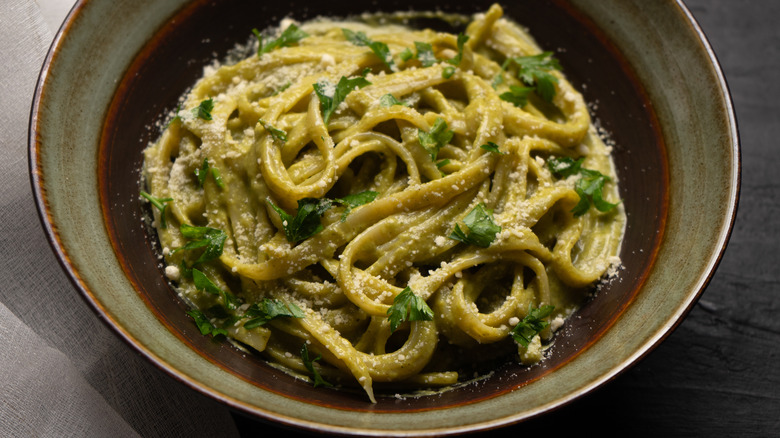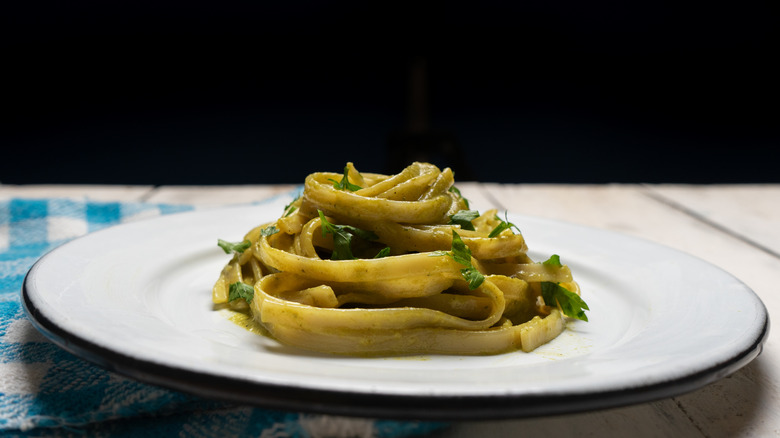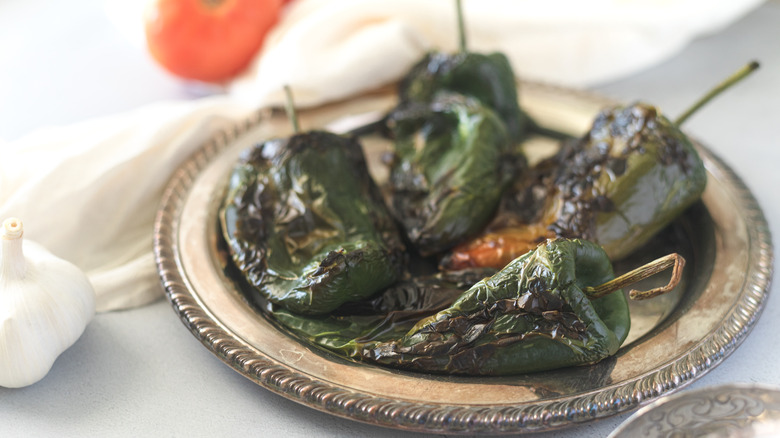Here's What Gives Espagueti Verde Its Green Hue
From the creamy rice pudding that is arroz con leche to the slow-roasted barbacoa that's simmered in chipotle, Mexican cuisine is a flurry of colors bursting with punchy spices and bold flavors. A dish that exemplifies this exquisitely is espagueti verde, a spaghetti-based creation aptly named for the vibrant green sauce that envelops its strands. It's typically served on special occasions like birthdays or weddings and is creamy, earthy, lightly spiced, and deliciously smoky.
It achieves its vivid green hue from poblano peppers. Originating from the Puebla area in east-central Mexico, fresh poblano peppers have a glimmering forest skin and an earthy flavor imbued with subtly spiced and sweet notes. For the espagueti verde, the peppers are roasted until their skins are blackened.
These charred pieces and the seeds are then removed to reveal the dark lime flesh beneath, which is then blended with other ingredients to achieve a lusciously smooth pasta sauce. This turns its bright, juicy color, a rich shade that's itching to transform opaque strands of spaghetti, a luminescent verdant hue that even Dr. Suess's green eggs and ham will struggle to rival.
The other delicious ingredients used in espagueti verde
While espagueti verde's appearance is truly stunning, it also boasts incredible flavor. The stove-top roasting of the poblano peppers adds rich, smoky aromas to the sweet, earthy undertones of the flesh. The skin also loses its bitter tang once blistered, which allows these gorgeous green flavors to take center stage. Blending the peppers with onions and garlic adds an incredible savory tang to the sauce, while milk, cream, or cheese smooths out any lingering bitter notes or spicy aromas.
One ingredient that has yet to be mentioned is the inclusion of chicken stock, although invisible to the eye, it adds a divine meatiness. It is quintessential for the authentic taste of this sauce. There are also various adaptations of espagueti verde and some incorporate other green additions. Common additions include cilantro, which would accentuate the peppery elements in the sauce with a slight lemony edge. It would also deepen the green color. For a spicy kick, you can also incorporate jalapeños alongside poblano peppers.
More dishes to use poblano peppers in
Espagueti verde is a fantastic celebration of the flavors of poblano peppers, but numerous other delightful dishes also resonate with the splendid taste of these green vegetables. Rajas con crema is a dish that combines roasted poblanos with cream, cheese, and onions. It's a dip usually served as a side or with corn tortillas. It can similarly be added to a verde chile, which sees chunks of pork gloriously tenderized in a rich, smoky-sweet salsa verde stew.
Once dried, these peppers are referred to as ancho chilies. These dried chiles are a dark rouge, highlighting that fresh poblano peppers are usually used unripe, as once they fully ripen, they turn a bright shade of red. Unlike other chili varieties, ancho chiles are deliciously smoky, sweet, and particularly mild. These chilies are traditionally used in mole poblano, where it's crafted into a rich pepper sauce infused with cacao and sugar that's served on top of turkey.
While espagueti verde may capture your attention, there is much more to explore below the splendid green hue of poblano peppers. Give it a taste and discover the culinary potential it holds.


